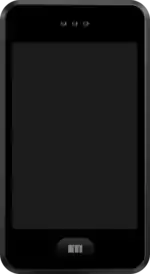Meizu M8
The Meizu M8 is a regular Windows CE-based 3.4" smartphone. It is popularly regarded as a Chinese iPhone-like design and similarity to the features and UI: The M8 runs a version of Microsoft Windows CE 6 with a modified GUI, similar to that of the iPhone.[1] It was created after the success of Meizu's 2 MP3/MP4 players — the M6 Mini Player and the M3 Music Card. The phone has been delayed several times due to not meeting Chinese cellular phone guidelines. Already it has drawn attention in the US, due to its similarity to iPhone, and also because of its unique features. Originally announced in two versions — an entry-level version with no camera and a standard version — only the standard model was released.
 | |
| Manufacturer | Meizu |
|---|---|
| Type | Candybar Smartphone |
| Release date | |
| Operating system | Mymobile (Based on Windows CE6.0) current version 0.9.8.22 |
| Memory | 256 MB |
| Storage | Flash memory 8 or 16 GB |
| Display | 720×480 px at 255 ppi, 3.4 in (86 mm), color LCD, 3:2 aspect ratio. |
| Input | Headphone jack · Wi-Fi (Public testing version only) |
| Camera | 3.2 megapixel |
| Connectivity | Quad band GSM 900 1800 GPRS/EDGE |
| Power | 3.7 V 1200 mAh Lithium-ion polymer battery |
| Dimensions | 105×58×11.8mm |
| Mass | 118 g (4.2 oz) |
| Successor | Meizu M9 |
Announcement dates
CEO Jack Wong had announced the Meizu M8 four days after the announcement of the iPhone as a direct competitor. The product was soon set for an October / November release. The M8 was released for public testing on April, 2007 in Shenzhen and Guangzhou, drawing positive reviews.[2]
Specifications
Some expected specifications of the M8 (not final):
- Dimensions: 108 mm × 59 mm × 12 mm (H × W × T)
- Processor: Samsung ARM11 667 MHz CPU
- Display: 3.4-inch 16600K (OS 65536 colors), 720 × 480 pixel resolution, LTPS TFT LCD, with multi touch (2 points)
- PC Interface: USB 2.0 Ultra Fast Data Transfer
- Flash Memory: 8 or 16 GB of built-in basic Memory
- Operating System: Windows CE for Meizu M8 (Based on Windows CE6.0) (Mymobile)
- Video Playback: AVI, MP4, RM, RMVB, 3GP, MOV, ASF, WMV, MPEG, MKV, FLV, MPEG-4/H.263/H.264 at 30FPS
| H.264 Baseline Profile :2.5Mbit/s,720×480,30fps; |
| MPEG-4 Simple Profile :2Mbit/s,720×480,30fps; |
| WMV 3 :3.2Mbit/s,720×480,30fps; |
| H.263 :1.5Mbit/s,720×480,30fps; |
| DIVX :5Mbit/s,720×480,30fps; |
| XVID :4Mbit/s,720×480,30fps; |
| DX50 :6Mbit/s,720×480,30fps; |
| MPEG-1 :1.5 Mbit/s,720×480,30fps; |
| FLV :500kbit/s,720×480,30fps |
- Camera: 3.2 MP camera on back. Supports auto-focus, no flash.
- Battery: Removable 1200 mAh Li-ion
Support for
- GSM (850,900,1800, 1900 MHz), GPRS, EDGE, WiFi
Additional features
- Light sensor allowing the phone to automatically adjust screen brightness in accordance to the lighting in the environment.
- Tilt and movement recognizing sensor that will allow it to auto-adjust screen orientation in accordance to tilting. It can also recognize movements (i.e. shaking), a feature which can be used for games.
- Proximity sensor for calling
CeBIT Appearance
Meizu appeared at CeBIT on March 4, 2008 with a non-functional, plastic prototype of the M8 able to display three screenshots of the UI, and a development board running partially working UI with most phone functions. No fully working unit was shown though.
On the second day of the exhibition, March 5, German police initiated by Sisvel raided 51 booths including Meizu; where a newly developed MP3 player was thought to infringe a Fraunhofer Society patent and confiscated.[3]
Production Halt
On October 9, 2010, it was reported that Meizu had shut down production of the M8 due to pressure from the Intellectual Property Offices and Apple Inc. because of its close similarities to the iPhone.[4] Apple also was looking to ban all sales of the M8 as well, which some media outlets have speculated could bankrupt the company due to losses from unsold inventory,[5] but no official word on this has been heard.
See also
References
- Meizu Enveils iPhone Clone: M8
- http://www.appleiphonereview.com/news-opinion/meizu-claims-m8-minione-redesign-barely-different/
- Libbenga, Jan. "Police raid CeBIT stands". www.theregister.com. Retrieved 2020-12-09.
- http://www.electronista.com/articles/10/10/09/apple.stops.meizu.over.m8.cloning.dispute/
- http://www.meizume.com/meizu-news/12290-apple-halts-meizu-m8-production-help-chinese-authorities.html